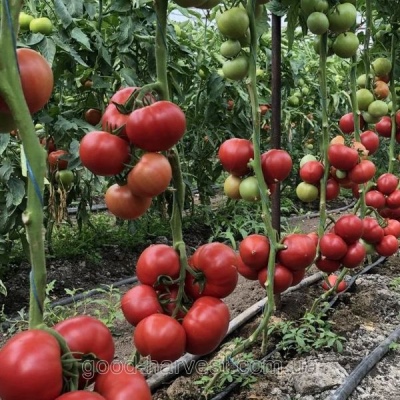
- Authors: Yuksel Tohum, Turkey
- Name synonyms: Eray, Pink Hit
- Category: hybrid
- Growth type: indeterminate
- Ripening period: early
- Growing conditions: for open ground, for film greenhouses, for greenhouses
- Marketability: high
- Transportability: good
- Bush size: tall
- Stem: powerful
Pink Hit is a hybrid of European selection, which managed to conquer the hearts of fans of large-fruited tomatoes. This novelty belongs to the category of beef in terms of size and structure of the pulp, perfect for fresh consumption and processing. And also the hybrid is found under the names Pink Hit, Eray.
Breeding history
A new hybrid of Turkish origin was developed by Yuksel Tohum. The firm sought to develop a tomato that is resistant to most diseases, unpretentious and well tolerated in unfavorable growing conditions. The hybrid was tested in the Russian Federation, was included in the State Register in 2012 under the name Eray.
Description of the variety
The hybrid has a powerful structure of the bushes. The shoots are tall, strong. The root system is highly developed. An indeterminate hybrid is capable of gaining height up to 2 m or more. The foliage is medium, the tops are small, dark green in color.
The main qualities of the fruit
This hybrid has large fruits weighing from 220-320 g. The shape of the tomatoes is neat, round, aesthetic. The shade of the skin is pink, the pulp is juicy. Fruits are collected in clusters of 4-5 pieces. Coloring is complete, without stains.
Taste characteristics
Tomatoes are sweet, of pleasant taste, saturated with sugars. Suitable for long-term storage. The tasting score is very high, as are the commercial qualities of the fruit. The fruit is characterized by a strong pleasant aroma.
Ripening and fruiting
The tomato is early in maturity. It reaches full ripeness in 60-65 days. The fruiting period is extended.
Yield
Pink Heath is a high-yielding hybrid. At least 3-3.5 kg of ripe tomatoes are collected from the bush. The collection is carried out with a frequency of at least 1 time in 3-7 days.
The timing of planting seedlings and planting in the ground
Tomatoes are transferred to open ground in the 2nd decade of April in the southern regions, in other climatic zones this stage can shift until the end of May. On average, it is worth waiting for the soil to warm up successfully to +10 degrees. The readiness of the bushes for transplantation will be indicated by the appearance of 9-10 true leaves, as well as the first flower brush.
Sowing seeds begins very early, in mid-February. It is in this case that the plants will be timely ready for transplantation.

Growing tomato seedlings is an extremely important process, because it largely depends on whether the gardener will be able to harvest at all. All aspects must be taken into account, from seedbed preparation to planting in the ground.
Landing scheme
There are no more than 2.5-2.7 plants per 1 m2. A tighter planting will result in over-thickening of the shoots. It is worth adhering to the scheme 37-40 per 100 cm.

Growing and care
The hybrid is cultivated in greenhouse conditions - under a film or in glazed shelters. In the open field, planting is carried out within the framework of 1 or 2 crop rotation - in the spring-summer period or summer-autumn. Bushes need shaping. In the greenhouse, it is recommended to maintain the temperature around +22 degrees, slightly increasing it during the fruiting period. If the plants are overheated, the ovaries will not form due to the sterilization of the pollen.
Planting Pink Hit hybrids should be done exclusively in fertile soil. It will be useful to pre-sow the ridges with green manure, or use areas where beans, zucchini, beans or corn were previously cultivated. Solanaceous crops are categorically not suitable as predecessors.
The bushes are tied after 7-10 days from the moment of transplantation to a permanent place. For this, a vertical trellis is used, on which the shoots are fixed with synthetic materials. So the plant will not suffer from the severity of the fruits as they gain weight.
Grassing bushes is required, but not too frequent. In this case, the bush is kept in 1 stem, unnecessary lateral shoots are eliminated every 5-7 days.
The watering regime for this tomato should be abundant enough, without gaps. But in the first 14 days after transplanting, the plants are generally not moistened, allowing them to properly acclimatize. Then a schedule is established with a frequency of 5-7 days, with the consumption of 15-20 liters for each bush. Watering is carried out in the root zone, should not affect the shoots.
And also during the care process, it is important to provide air access to the roots of tomatoes, especially in the greenhouse. Loosening the soil, regular airing - these are just a small part of what can be done to improve the growth and development of bushes.




A plant needs different micronutrients at each stage of growth. All fertilizers can be divided into two groups: mineral and organic. Folk remedies are often used: iodine, yeast, bird droppings, eggshells.
It is important to observe the rate and period of feeding. This also applies to folk remedies and organic fertilizers.
Disease and pest resistance
The plant is immune to most of the most common tomato diseases. The hybrid is resistant to fusarium wilt, tobacco mosaic virus, verticillosis. May be affected by the yellow curl virus.


Resistant to adverse weather conditions
Hybrid Pink Hit belongs to the category of stress-resistant. It tolerates sudden changes in ambient temperature.
Growing regions
The hybrid form is best adapted to growing outdoors in a subtropical climate. Here they manage to harvest 2 crops during the season. In colder regions, tomatoes are grown equally well in greenhouses.

























































































